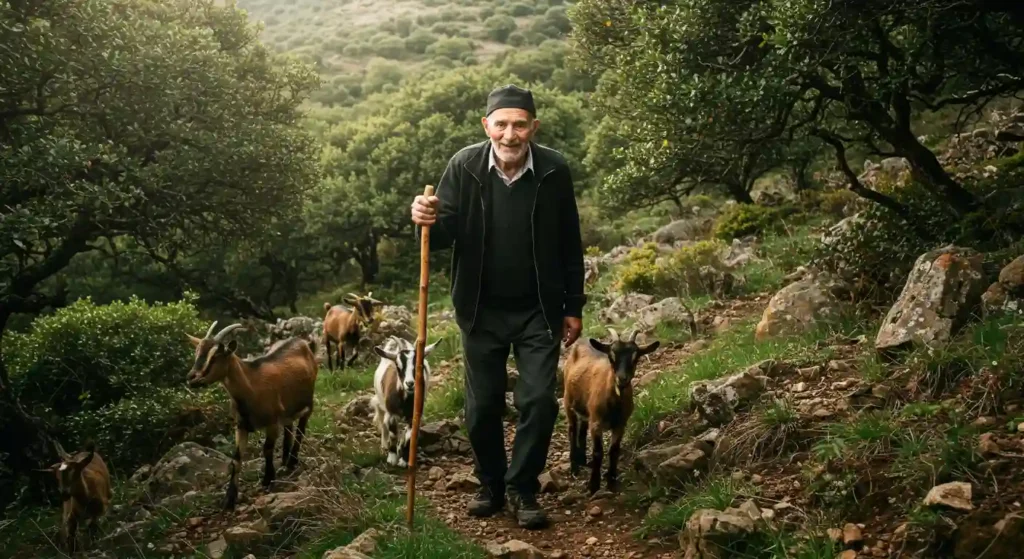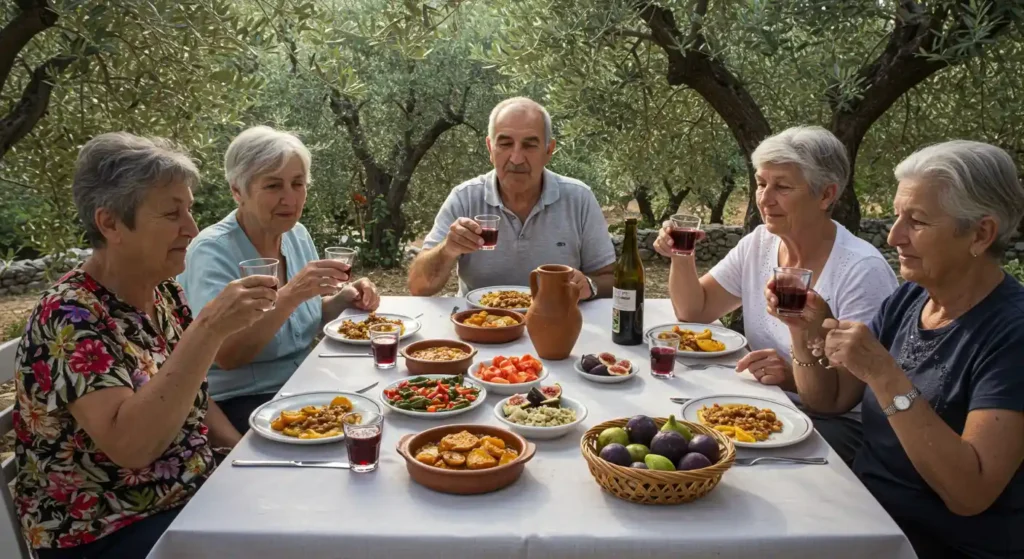Introduction
In recent years, the Blue Zones lifestyle concept gained global attention by revealing diets and habits of the world’s healthiest, longest-living people. Blue Zones, a term by Dan Buettner, are regions where people live past 90 with exceptional health and happiness. These zones include Okinawa (Japan), Sardinia (Italy), Nicoya (Costa Rica), Ikaria (Greece), and Loma Linda (California).
Their secret? A powerful combination of lifestyle, diet and habits, strong social networks, and purpose-driven lives. Understanding these elements offers valuable insights for anyone seeking longevity and better well-being.
Blue Zones Lifestyle: The Power of Purpose and Daily Movement

In the world’s healthiest regions, known as Blue Zones, people live longer not by chance, but by following a natural and intentional lifestyle. These communities thrive on two powerful pillars: having a strong sense of purpose and staying active through daily, organic movement. Together, these habits form a core part of the Blue Zones lifestyle and are key drivers of exceptional longevity.
Let’s explore how these two factors purpose and movement intertwine in the diet and habits of centenarians across the globe, contributing not only to physical health but also to mental resilience and emotional well-being.
Living with Ikigai or Plan de Vida: Purpose That Fuels Longevity
One of the most fascinating aspects of the Blue Zones lifestyle is the emphasis on living with purpose. In Okinawa, Japan, this concept is called Ikigai, meaning “a reason for being.” In Nicoya, Costa Rica, a similar belief is known as Plan de Vida, or “life plan.” Regardless of the terminology, the meaning is universal: purpose gives people a reason to get up each day, even into their 90s and 100s.
This deep-rooted sense of meaning is more than just a philosophical ideal it’s also scientifically supported. A 2014 NIH study found that a strong sense of purpose lowers risks of heart disease, cognitive decline, stress, and depression key factors in longevity and healthy aging.
Purpose, it seems, isn’t just good for the soul it’s vital for the body too.
Natural Movement Over Structured Exercise in the Blue Zones Lifestyle
Unlike many Western societies where fitness often revolves around structured gym workouts and scheduled exercise programs, residents of Blue Zones stay active in a much more natural and sustainable way. This is an important distinction that defines their lifestyle and daily diet and habits.
In Okinawa, elders work in their gardens, squat to prepare food, and walk daily to local markets. People don’t need gym memberships or equipment for these activities because they simply build them into their daily routines.
The benefits of this kind of natural movement are profound. Continuous, low-intensity activity throughout the day improves circulation, supports joint health, maintains muscular strength, and contributes to overall cardiovascular well-being. It also helps regulate weight, which is a crucial element of disease prevention and longevity.
As Dan Buettner, the founder of the Blue Zones project, emphasizes: “The world’s longest-lived people don’t pump iron, run marathons, or join gyms. Instead, they live in environments that constantly nudge them into moving without thinking about it.” (Buettner, The Blue Zones Solution, 2015)
Diet and Habits That Promote Longevity in the Blue Zones Lifestyle

A core pillar of the Blue Zones lifestyle is the strong link between diet and habits and remarkable longevity. Residents follow natural, intuitive eating rather than strict nutrition trends. Their approach is simple, balanced, and deeply rooted in culture and community.
From plant-based meals to mindful eating patterns and even the occasional glass of red wine, these time-tested customs offer valuable insights for anyone looking to build a healthier, more sustainable lifestyle.
Plant-Based Eating and Longevity
One of the most striking similarities across all Blue Zones is a predominantly plant-based diet. Meals are centered around whole, nutrient-rich foods such as:
- Legumes (like black beans, lentils, chickpeas)
- Dark leafy greens (such as spinach, kale, and dandelion greens)
- Whole grains (like oats, barley, and brown rice)
- Fresh, seasonal fruits
- Nuts and seeds, which provide healthy fats and protein
Animal products, including meat and dairy, are consumed only in small amounts typically just a few times a month, and often reserved for special occasions.
This diet and habits pattern not only supports heart and metabolic health but also reduces inflammation, which is known to accelerate aging and chronic disease.
As highlighted by the American Journal of Lifestyle Medicine, “Plant-based diets are associated with lower rates of chronic illnesses and increased longevity across multiple populations” (2019).
Moreover, these ingredients are often grown locally and prepared fresh, enhancing both nutrition and flavor while minimizing processed foods.
The 80% Rule – Mindful Eating in the Blue Zones Lifestyle
Another common habit that supports longevity in Blue Zones is the practice of eating until one is satisfied, but not full. In Okinawa, this is known as “Hara Hachi Bu”, which translates to “eat until you are 80% full.”
This seemingly small change in mindset has a profound impact:
- It reduces calorie intake without the need for strict dieting.
- It supports digestion and energy levels.
- It cultivates mindful awareness around food and hunger.
By stopping before they feel “stuffed,” residents avoid the long-term health risks associated with overeating, including obesity, type 2 diabetes, and cardiovascular disease.
This rule also emphasizes the importance of slowing down, chewing thoroughly, and truly enjoying each meal habits often lost in fast-paced, modern societies.
Moderate Alcohol Intake in a Healthy Lifestyle
Interestingly, people in some Blue Zones, especially Sardinia and Ikaria, not only accept but celebrate moderate alcohol consumption. Instead of binge drinking or drinking alone, they enjoy wine:
- In moderation – typically 1–2 small glasses per day
- With food – enhancing digestion and meal satisfaction
- With friends and family – promoting social bonds
The wine consumed is often homemade, rich in polyphenols and antioxidants, and part of a holistic, joy-filled lifestyle that includes laughter, community, and relaxation.
According to research published in The Journals of Gerontology, “moderate wine consumption, particularly when combined with a Mediterranean diet, may contribute to longer life expectancy” (2017).
It’s important to note that moderation is key. In all Blue Zones, alcohol is not abused but treated as a complement to healthy living never a crutch.
How Social Connections Shape Lifestyle and Longevity in the Blue Zones

A cornerstone of the Blue Zones lifestyle is the strength and depth of social connections. While many modern societies face an epidemic of loneliness, the world’s longest-living people thrive in tightly woven social environments that promote not just happiness but also longevity.
In every Blue Zone, meaningful relationships serve as emotional anchors and lifestyle motivators. These connections foster resilience, reduce stress, and support healthy diet and habits, making social interaction an essential part of the blueprint for long life.
Social relationships are not just important they are a matter of life and death. In every Blue Zones lifestyle, strong social ties are a defining characteristic that boosts mental, emotional, and physical health.
Family First and Lifelong Friendships Fuel Longevity
One of the most impactful lifestyle choices observed in the Blue Zones is the prioritization of family and long-term friendships. Unlike in many Western societies, where elders often live in isolation, Blue Zone centenarians usually remain deeply integrated into their family units.
In Nicoya, Costa Rica, for example, aging parents often live with or near their adult children and grandchildren. This arrangement fosters mutual caregiving and emotional support, which studies have shown to significantly reduce stress and anxiety levels in older adults.
In Okinawa, the concept of moai small, lifelong social circles ensures that no one faces life’s challenges alone. These groups meet regularly to share food, stories, and emotional support from childhood into old age.
A landmark study by Harvard Health Publishing (2017) emphasized that “strong social connections are as important as adequate sleep and a healthy diet when it comes to overall health and longevity.” (Source)
Meanwhile, in Loma Linda, California, Seventh-day Adventists gather weekly for worship, meals, and community service. This faith-based fellowship provides both spiritual grounding and a consistent source of social interaction both essential to the Blue Zones lifestyle.
The emotional support from close relationships boosts mental health and encourages healthier diet, habits, movement, and mutual care.
Belonging to a Community with Shared Values and Purpose
Equally important to personal relationships is a strong sense of community. Blue Zones residents don’t just live near others they engage, participate, and contribute regularly.
Their neighborhoods are often small, walkable, and socially active, which makes spontaneous connections and outdoor gatherings a regular occurrence. Whether it’s a village square in Ikaria or a church potluck in Loma Linda, these shared spaces foster a lifestyle of connection and purpose.
Furthermore, religious and spiritual practices play a key role in creating routine, reflection, and a feeling of belonging. Participation in spiritual activities be it prayer, meditation, or communal worship helps reduce cortisol levels, enhances emotional stability, and reinforces strong moral and social frameworks.
As noted by the Journal of Aging and Health (2015), “Religious participation is associated with lower mortality rates, better mental health, and increased life satisfaction among older adults.”
This shared lifestyle of values and support naturally reinforces healthier behaviors. When the community shares the same priorities including nutritious eating, regular physical activity, and rest individuals are more likely to stick to beneficial diet and habits without feeling alone or deprived.
Stress Management and Rest: Essential Lifestyle Habits in the Blue Zones for Longevity

In the Blue Zones lifestyle, rest is not an afterthought it is a vital part of daily life. Besides diet and exercise, stress management, spiritual reflection, and rest are key to protecting body and mind from harm.
By weaving calmness and mindfulness into their everyday routines, residents of the Blue Zones create a lifestyle that supports emotional resilience, promotes better choices in diet and habits, and, ultimately, enhances longevity.
Daily Rituals That Promote Mental Balance and Longevity in Blue Zones
In each Blue Zone region, centenarians share something in common: the presence of daily rituals designed to soothe the mind and reduce stress. These simple, intentional practices deeply root themselves in culture and tradition while perfectly aligning with modern neuroscience and lifestyle medicine.
Some of the most common rituals include:
- Prayer or Meditation: In Loma Linda, daily prayer helps Seventh-day Adventists reconnect with their values and reduce mental clutter. Similarly, Ikarians engage in spiritual reflection that calms the nervous system and nurtures emotional well-being.
- Napping: In Greece, particularly Ikaria, afternoon naps are a cultural norm. According to a study published in the journal Archives of Internal Medicine (2007), regular napping can reduce the risk of heart disease by up to 37%. (Source)
- Quiet time in nature, like gardening or walking hills, is a key part of the Blue Zones lifestyle connection. These natural escapes encourage slow, mindful movement and reduce the overstimulation that often fuels stress.
- Gratitude Before Meals: Giving thanks before eating is a widespread habit. This brief pause helps cultivate appreciation, slows the pace of life, and enhances digestion creating not just healthier bodies, but also more mindful eaters.
As Dr. Dean Ornish, a pioneer in lifestyle medicine, has noted:
“Chronic stress increases inflammation, which accelerates aging and chronic disease.”
Reducing stress, therefore, is more than just a feel-good idea it’s a measurable step toward longevity. When cortisol levels remain chronically high, chronic inflammation develops in the body, leading to heart disease, diabetes, depression, and even dementia.
Residents of the Blue Zones have seemingly unlocked a secret: rather than treating stress after it strikes, they prevent it with rituals of rest, connection, and meaning built into the fabric of everyday life.
Final Thoughts on Embracing the Blue Zones Lifestyle
The beauty of the Blue Zones lifestyle lies in its simplicity. There are no secret supplements, complex workout plans, or rigid diets. Instead, people live a lifestyle centered on purpose, natural movement, balanced diet and habits, strong relationships, and stress-free routines.
✅ Ready to Transform Your Lifestyle?
Boost Your Blood Flow & Stamina Naturally with Circ02 – Backed by Clinical Science!Choose one habit whether it’s eating more plant-based meals, walking more often, or reconnecting with a loved one and build from there.






